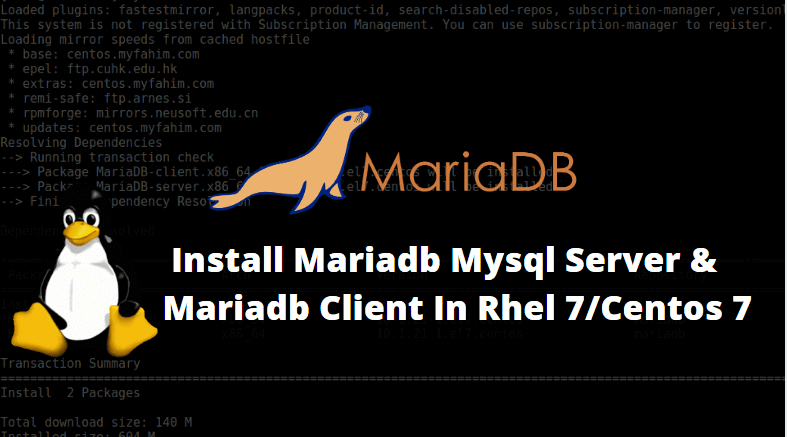- For a number of Linux distributions, you can install MySQL using the MySQL Yum repository instead of the platform's native software repository. See Section 2.5.1, “Installing MySQL on Linux Using the MySQL Yum Repository” for details.
- CPAN installation. Installation of DBD::mysql can be incredibly easy: cpan install DBD::mysql. If you are using the CPAN module for the first time, just answer the questions by accepting the defaults which are fine in most cases. If you are using an older version of Perl, you might instead need a. Perl -MCPAN -e shell install DBD::mysql.
- On a tutorial for installing SendEmail, I found instructions to install 2 prequisites, 2 perl modules. Apt-get install 'perl(Net::SSLeay)' 'perl(IO::Socket::SSL)' This syntax also resulted strange to my Debian 9.
2.5.7 Installing MySQL on Linux from the Native Software Repositories
MySQL, the world's most popular open-source relational database management system is not available in the default Debian's repositories. This tutorial, explains how to install and secure MySQL on Debian 10 from the MySQL Apt Repository.
Debian Install Perl Module
Many Linux distributions include a version of the MySQL server, client tools, and development components in their native software repositories and can be installed with the platforms' standard package management systems. This section provides basic instructions for installing MySQL using those package management systems.
Native packages are often several versions behind the currently available release. You are also normally unable to install development milestone releases (DMRs), since these are not usually made available in the native repositories. Before proceeding, we recommend that you check out the other installation options described in Section 2.5, “Installing MySQL on Linux”.
Distribution specific instructions are shown below:
Red Hat Linux, Fedora, CentOS
For a number of Linux distributions, you can install MySQL using the MySQL Yum repository instead of the platform's native software repository. See Section 2.5.1, “Installing MySQL on Linux Using the MySQL Yum Repository” for details.
For Red Hat and similar distributions, the MySQL distribution is divided into a number of separate packages,
mysqlfor the client tools,mysql-serverfor the server and associated tools, andmysql-libsfor the libraries. The libraries are required if you want to provide connectivity from different languages and environments such as Perl, Python and others.To install, use the yum command to specify the packages that you want to install. For example:
MySQL and the MySQL server should now be installed. A sample configuration file is installed into
/etc/my.cnf. To start the MySQL server use systemctl:The database tables are automatically created for you, if they do not already exist. You should, however, run mysql_secure_installation to set the root passwords on your server.
Debian, Ubuntu, Kubuntu
For supported Debian and Ubuntu versions, MySQL can be installed using the MySQL APT Repository instead of the platform's native software repository. See Section 2.5.2, “Installing MySQL on Linux Using the MySQL APT Repository” for details.
On Debian and related distributions, there are two packages for MySQL in their software repositories,
mysql-clientandmysql-server, for the client and server components respectively. You should specify an explicit version, for examplemysql-client-5.1, to ensure that you install the version of MySQL that you want.To download and install, including any dependencies, use the apt-get command, specifying the packages that you want to install.
Before installing, make sure that you update your
apt-getindex files to ensure you are downloading the latest available version.The apt-get command installs a number of packages, including the MySQL server, in order to provide the typical tools and application environment. This can mean that you install a large number of packages in addition to the main MySQL package. Coreldraw 2019 crack getintopc.
During installation, the initial database is created, and you are prompted for the MySQL root password (and confirmation). A configuration file is created in
/etc/mysql/my.cnf. An init script is created in/etc/init.d/mysql.The server should already be started. You can manually start and stop the server using:
The service is automatically added to the 2, 3 and 4 run levels, with stop scripts in the single, shutdown and restart levels.
LiveJournal requires several Perl modules to be installed. Installing these modules requires a fully working perl and C development environment (including a C compiler and make tool).
Debian Perl Dbd Mysql Install Linux Command


Note
Some modules such as GD and Compress::Zlib Office 2016 mac update. require certain system libraries to be pre-installed on your machine. Please read the author-provided README files for each module before proceeding further.
This may mean particular development packages need to be installed on your system, before a Perl module will install in CPAN. For example, on a Debian system, to install the optional Math::BigInt::GMP module, you should install libgmp3-dev first. Similarly, you may need to install the “development” packages for MySQL and GD on your system, before attempting to install the related Perl modules. The names of these packages varies between Linux distributions, but are often called <packagename>-dev. Installing binary packages of modules provided through your Linux distribution is the easier option.
Table 6.1. Required Perl Modules
| DateTime | libdatetime-perl |
| DBI | libdbi-perl |
| DBD::mysql | libdbd-mysql-perl |
| Class::Autouse | libclass-autouse-perl |
| Digest::MD5 | libmd5-perl |
| Digest::SHA1 | libdigest-sha1-perl |
| HTML::Template | libhtml-template-perl |
| Image::Size | libimage-size-perl |
| MIME::Lite | libmime-lite-perl |
| MIME::Words | libmime-perl |
| Compress::Zlib | libcompress-zlib-perl |
| Net::DNS | libnet-dns-perl |
| URI::URL | liburi-perl |
| HTML::Tagset | libhtml-tagset-perl |
| HTML::Parser | libhtml-parser-perl |
| LWP::Simple | libwww-perl |
| LWP::UserAgent | libwww-perl |
| GD | libgd-gd2-perl |
| Mail::Address | libmailtools-perl |
| Unicode::MapUTF8 | libunicode-maputf8-perl |
| XML::Simple | libxml-simple-perl |
| IO::WrapTie | libio-stringy-perl |
| Unicode::CheckUTF8 | |
| Captcha::reCAPTCHA | libcaptcha-recaptcha-perl |
| Digest::HMAC_SHA1 | libdigest-hmac-perl |
Optional modules Minitool partition wizard full version with key.
- GD::Graph, libgd-graph-perl
- Required for making graphs for the statistics page.
- Proc::ProcessTable, libproc-process-perl
- Better reliability for starting daemons necessary for high-traffic installations.
- RPC::XML, librpc-xml-perl
- Required for outgoing XML-RPC support
- SOAP::Lite, libsoap-lite-perl
- Required for XML-RPC support.
- XML::RSS, libxml-rss-perl
- Required for retrieving RSS off of other sites (syndication).
- String::CRC32, libstring-crc32-perl
- Required for palette-altering of PNG files. Only necessary if you plan to make your own S2 styles that use PNGs, not GIFs.
- XML::Atom, libxml-atom-perl
- Required for Atom API support.
- Math::BigInt::GMP, libmath-bigint-gmp-perl
- Aides Crypt::DH so it is not crazy slow.
- URI::Fetch, liburi-fetch-perl
- Required for OpenID support.
- Crypt::DH, libcrypt-dh-perl
- Required for OpenID support.
- Image::Magick, perlmagick
- Required for the userpic factory.
- Class::Accessor, libclass-accessor-perl
- Required for TheSchwartz job submission.
- Class::Trigger, libclass-trigger-perl
- Required for TheSchwartz job submission.
- Class::Data::Inheritable, libclass-data-inheritable-perl
- Required for TheSchwartz job submission.
- GnuPG::Interface, libgnupg-interface-perl
- Required for email posting.
- Mail::GnuPG, libmail-gnupg-perl
- Required for email posting.
- Text::vCard, libtext-vcard-perl
- Used to generate user vCards.
- IP::Country::Fast,
- Required for country lookup with IP address.
- GTop,
- Required for Apache per-request database logging.
Debian Install. If you are using Debian the following command should retrieve and build every required module. If there are any modules not yet packaged in Debian, you can use CPAN to install those — Unicode::CheckUTF8 is an example.:
And likewise for the optional modules:
Using CPAN. Alternatively, you can use CPAN to install the modules:
From the root prompt on your server, invoke the CPAN shell:
Once the Perl interpreter has loaded (and been configured), you can install modules with: install .MODULENAME
The first thing you should do is upgrade your CPAN:
Debian Perl Dbd Mysql Install Linux Centos
Once it is completed, type:
Now, enter the following command to retrieve all of the required modules:
And likewise for the optional modules:
Note


Perl Dbd Mysql Download
Be aware that after freshly installing makegccmake:
Tip
Debian Perl Dbd Mysql Install Linux Virtualbox
You can find out the locations of the various tools the CPAN setup routine (o conf) will ask you about by using the whereis command, at a command prompt. For example:
Debian Perl Dbd Mysql Install Linux Mint
To make sure you have the necessary modules run the included tool: $/bin/checkconfig.plLJHOME--needed-debs --only=modules
If checkconfig.pl does not detect all of the required modules, it will tell you which ones you are missing. You should install those.